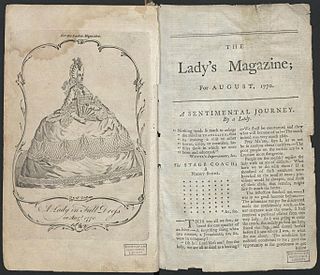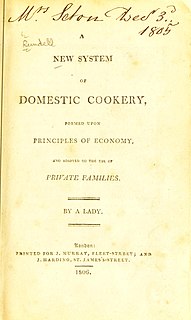
The Lady's Monthly Museum; Or, Polite Repository of Amusement and Instruction [note 1] was an English monthly women's magazine published between 1798 and 1832.

The Lady's Monthly Museum; Or, Polite Repository of Amusement and Instruction [note 1] was an English monthly women's magazine published between 1798 and 1832.
The Lady's Magazine , a women's magazine founded in 1770 with a "pseudo-genteel and sentimental emphasis", encouraged successors. The Lady's Monthly Museum; Or, Polite Repository of Amusement and Instruction was started in 1798 as one of the more successful of the group. [1] The magazine was published by Vernor and Hood, [2] and was one of the era's more popular publications. [3]
It merged with The Lady's Magazine in 1832, becoming known as The Lady's Magazine and Museum of the Belles Lettres, Fine Arts, Music, Drama, Fashions, etc., and finally ceased publication in 1847. [4] [5]
The magazine positioned itself to appeal directly to women. It featured articles on fashion, biographies and portraits of aristocratic persons of interest, essays, and poems. Serialised stories also appeared in the Lady's Monthly Museum, making the publication one of the first to publish novels before they became available as books. [6]
The Lady's Monthly Museum claimed in 1798 that its contributors were "Ladies of established Reputation in the literary Circles". [7] However, contributing writers were poorly paid for their efforts. One of its regular writers, Mary Pilkington, often asked for increased compensation and eventually left the magazine in favour of the Lady's Magazine . [7] Pilkington, who mainly contributed anonymously, wrote poetry, stories, biographies, and social gossip for the magazine, and also did editorial work. [2] From 1830, Charles Robert Forrester was also a contributor.

Isabella Mary Beeton, known as Mrs Beeton, was an English journalist, editor and writer. Her name is particularly associated with her first book, the 1861 work Mrs Beeton's Book of Household Management. She was born in London and, after schooling in Islington, north London, and Heidelberg, Germany, she married Samuel Orchart Beeton, an ambitious publisher and magazine editor.

The Lady's Magazine; or Entertaining Companion for the Fair Sex, Appropriated Solely to Their Use and Amusement, was an early British women's magazine published monthly from 1770 until 1847. Priced at sixpence per copy, it began publication in August 1770 by the London bookseller John Coote and the publisher John Wheble. It featured articles on fiction, poetry, fashion, music, and social gossip and was, according to the Victoria and Albert Museum, "the first woman's magazine to enjoy lasting success."

Anna Seward was an English Romantic poet, often called the Swan of Lichfield. She benefited from her father's progressive views on female education.
Mary Pilkington was an English novelist and poet. Many of her over forty novels were written for children.

The Analytical Review was an English periodical that was published from 1788 to 1798, having been established in London by the publisher Joseph Johnson and the writer Thomas Christie. Part of the Republic of Letters, it was a gadfly publication, which offered readers summaries and analyses of the many new publications issued at the end of the eighteenth century.
Dorothea Primrose Campbell was a poet, novelist and teacher from the Shetland islands of Scotland. She wrote a novel, Harley Radington: A Tale (1821), and had poems and short fiction printed in London periodicals. Campbell continued to write in the face of family trauma, poverty, and ethnic and gender discrimination. Her melodic, whimsical poetry and her works of fiction are seen as revealing works that cover historical and societal barriers which Campbell herself was facing.
The Monthly Repository was a British monthly Unitarian periodical which ran between 1806 and 1838. In terms of editorial policy on theology, the Repository was largely concerned with rational dissent. Considered as a political journal, it was radical, supporting a platform of: abolition of monopolies ; abolition of slavery; repeal of "taxes on knowledge"; extension of suffrage; national education; reform of the Church of England; and changes to the Poor Laws.

The Ladies' Diary: or, Woman's Almanack appeared annually in London from 1704 to 1841 after which it was succeeded by The Lady's and Gentleman's Diary. It featured material relating to calendars etc. including sunrise and sunset times and phases of the moon, as well as important dates, and a chronology of remarkable events.

The Ladies' Mercury was a periodical published in London by the Athenian Society notable for being the first periodical in English published and specifically designed for women readers.

La Belle Assemblée was a British women's magazine published from 1806 to 1837, founded by John Bell (1745–1831).

The Royal American Magazine, or Universal Repository of Instruction and Amusement was a short-lived monthly periodical published in Boston, Massachusetts, by Isaiah Thomas and later by Joseph Greenleaf. It supported patriot and revolutionary sentiment in the Colonies against the Kingdom of Great Britain, and had contributors that included John Hancock and Paul Revere.

The Englishwoman's Domestic Magazine (EDM) was a monthly magazine which was published between 1852 and 1879. Initially, the periodical was jointly edited by Isabella Mary Beeton and her husband Samuel Orchart Beeton, with Isabella contributing to sections on domestic management, fashion, embroidery and even translations of French novels. Some of her contributions were later collected to form her widely acclaimed Book of Household Management. The editors sought to inform as well as entertain their readers; providing the advice of an 'encouraging friend' and 'cultivation of the mind' alongside serialised fiction, short stories and poetry. More unusually, it also featured patterns for dressmaking.

The Lady's Realm was a British women's magazine published from 1896 until 1914, possibly until 1915. It primarily targeted upper-class readers as well as an aspirational middle-class audience, featuring photographs, poems, fiction, and columns by popular authors such as Marie Corelli, Frances Hodgson Burnett, Jack London, and H. G. Wells. The London Season was regularly covered, with visuals of significant society figures and débutantes appearing. Fashion trends in Paris and London were frequently discussed as well, particularly by its fashion editor Marian Pritchard.

Maria Eliza Rundell was an English writer. Little is known about most of her life, but in 1805, when she was over 60, she sent an unedited collection of recipes and household advice to John Murray, of whose family—owners of the John Murray publishing house—she was a friend. She asked for, and expected, no payment or royalties.

Isabella Beetham was an 18th-century British silhouette artist. She began her career by cutting the silhouette images. After studying painting with successful miniature portraitist John Smart, Beetham painted silhouettes to be framed or miniatures were made for jewelry. From 1785 to 1809, she had a business on 27 Fleet Street in London, where she produced silhouettes of men and women. She is considered one of the great 18th century silhouette artists, along with John Miers.

The Universalist and Ladies' Repository was an American periodical published by the Universalist Church of America in Boston, Massachusetts under various names during the period of 1832 to 1873. During the period of 1834-43, it was published in Boston by Benjamin B. Mussey as Universalist and Ladies' Repository. In 1844 and through 1873, it was published in Boston by Abel Tompkins as Ladies' Repository.
Works cited